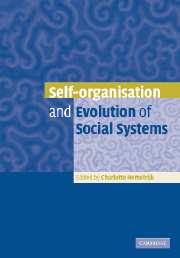Book contents
- Frontmatter
- Contents
- List of contributors
- Preface
- Introduction
- 1 From unicellular to multicellular organisation in the social amoeba Dictyostelium discoideum
- 2 Optimality of communication in self-organised social behaviour
- 3 The interplay of intracolonial genotypic variance and self-organisation of dominance hierarchies in honeybees
- 4 Traffic rules of fish schools: a review of agent-based approaches
- 5 A process-oriented approach to the social behaviour of primates
- 6 Order and noise in primate societies
- 7 Self-organisation in language
- 8 Dictatorship effect of majority rule in voting in hierarchical systems
- 9 Natural selection and complex systems: a complex interaction
- 10 Interlocking of self-organisation and evolution
- Index
- References
8 - Dictatorship effect of majority rule in voting in hierarchical systems
Published online by Cambridge University Press: 07 December 2009
- Frontmatter
- Contents
- List of contributors
- Preface
- Introduction
- 1 From unicellular to multicellular organisation in the social amoeba Dictyostelium discoideum
- 2 Optimality of communication in self-organised social behaviour
- 3 The interplay of intracolonial genotypic variance and self-organisation of dominance hierarchies in honeybees
- 4 Traffic rules of fish schools: a review of agent-based approaches
- 5 A process-oriented approach to the social behaviour of primates
- 6 Order and noise in primate societies
- 7 Self-organisation in language
- 8 Dictatorship effect of majority rule in voting in hierarchical systems
- 9 Natural selection and complex systems: a complex interaction
- 10 Interlocking of self-organisation and evolution
- Index
- References
Summary
Introduction
In recent years statistical physics (Pathria, 1972; Ma, 1976) has been applied to a large spectrum of fields outside the scope of non-living matter (Bunde et al., 2002). While applications to social sciences are growing, they are still scarce (de Oliveira et al., 2000). In this chapter we analyse a basic ingredient of social organisations: the legitimacy of top leadership with respect to the distribution of support for various political trends present at the bottom of the organisation.
In hierarchical democratic systems each level is chosen from the one just below using a local majority rule. In principle this is supposed to yield 100% power to the larger trend. In the case of two competing trends, it means receiving more than 50% of the overall global support. This democratic ideal can seldom be satisfied, because the trend leading the organisation has several advantages. We show that accounting for such an asymmetry between the ruling trend and the challenging one may turn a democratic system into a drastic dictatorship.
This paradox is a consequence of the underlying dynamics associated with multi-level elections. It appears to obey a threshold-like dynamics, which can lead to democratic self-elimination of the huge majority against a minority trend which is in power (Galam, 1986). Indeed, repeated elections can drive the threshold for attaining power to a significant asymmetric value. For instance, it can be down to 23% for the group already in power and up to 77% for its challenging competitor.
- Type
- Chapter
- Information
- Self-Organisation and Evolution of Biological and Social Systems , pp. 140 - 150Publisher: Cambridge University PressPrint publication year: 2005



